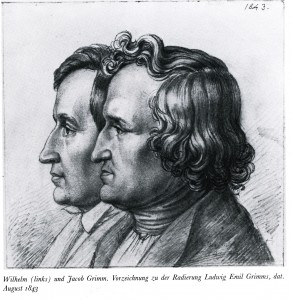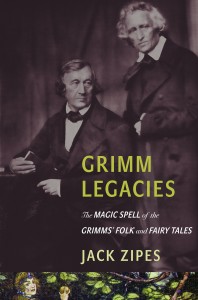By Jack Zipes (Guest Contributor)
From the beginning of their work as folklorists Jacob and Wilhelm Grimm were very much aware of the never-ending process of storytelling and collecting folk tales. They knew there was a rich abundance of stories which they had yet to discover and which other people should also seek. Throughout their lives, the Grimms had encouraged friends, colleagues, and strangers to gather and share tales that emanated from an oral tradition.
The Golden Casket
By the time that they stopped collecting tales, they had fully realized the profound and prophetic quality of their simple last tale about a mysterious golden casket. In fact, they had opened the golden casket so wide that thousands if not hundreds of thousands of wonderful folk tales came pouring out into books throughout Europe and have kept coming. They had looked and found the right key that has opened up a worldwide cultural legacy that is unfathomable.
In the centuries before the Grimms produced the Kinder-und Hausmärchen (Children’s and Household Tales) the literate people of Europe had generally ignored or looked down upon the stories of the common people. Ironically, these were the tales with which they had also been raised. It was not until the end of the eighteenth century and beginning of the nineteenth century when nation-states were being formed that their attitudes toward history and national identity changed and led to a “romantic” rediscovery of fairy tales and other short genres such as animal stories, legends, humorous anecdotes, witch and ghost stories, and so on.
Setting the Standard in Folklore
The Grimms were not the first scholars to turn their attention to folk tales which they considered gems of German culture, relics that needed preservation. But they played a significant part in a widespread cultural trend and set high standards for collecting folk tales that marked the work of most European and American folklorists up through the twentieth-first century.
In fact, their long-term, scholarly investigation of narratives from all parts of Europe was a direct or indirect inspiration for philologists, collectors, writers, and translators of tales. As a result of the Grimms’ prodigious and timely influence, scholars in one country after another utilized folklore as a vehicle to promote a national language, literature, history, and mythology. The result is that the Grimms have left many legacies behind them not just one.
From the nineteenth century to the present the Grimms came to play a pivotal and unusual role in the evolution of western folklore and in the history of the most significant cultural genre in the world, the fairy tale. In the end, what the Grimms sought to bestow upon the German people has now become a global heritage.
Jack Zipes is professor emeritus of German at the University of Minnesota. In addition to his scholarly work on folk and fairy tales, he is an active storyteller in public schools. Some of his more recent publications include: The Enchanted Screen: The Unknown History of Fairy-Tale Films (2010), The Irresistible Fairy Tale (2012), and The Golden Age of Folk and Fairy Tales (2013). He has just published Grimm Legacies (2014) which covers topics such as the transformation of the Grimms’ tales into children’s literature, the Americanization of the tales, the Grimmness of contemporary fairy tales, and the utopian impulse of fairy tales.
W&M is excited to have three (3) copies of Grimm Legacies for this month’s giveaway! Be sure to enter below by 11:00 pm EST on November 27th to qualify (your entry includes a subscription to W&M Monthly).
Please note that at this time we can only ship within the US.

